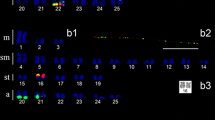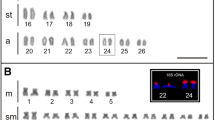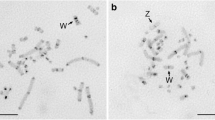Abstract
To contribute to the knowledge of fish genomes, we identified and characterized by means of nucleotide sequencing and physical chromosome mapping, three classes of repetitive DNAs in the genome of the South American cichlid fish Astronotus ocellatus. The first class corresponds to a satellite DNA family (AoSat) that shares similarity with a centromeric satellite DNA of the pufferfish Tetraodon nigroviridis. The second repetitive DNA class (AoRex3) is related to the retrotransposon Rex3, which is widely distributed among teleost fishes. The last repetitive element (AoLINE) shows a high similarity to the CR1-like LINE element of other teleosts. The three isolated repetitive elements are clustered in the centromeric heterochromatin of all chromosomes of the complement. The repetitive sequences are not randomly distributed in the genome, suggesting a pattern of compartmentalization on chromosomes.





Similar content being viewed by others
References
Altschul SF, Gish W, Miller W, Myers EW, Lipman DJ (1990) Basic local alignment search tool. J Mol Biol 215:403–410
Bartolomé C, Maside X, Charlesworth B (2002) On the abundance and distribution of transposable elements in the genome of Drosophila melanogaster. Mol Biol Evol 19:926–937
Bertollo LAC, Takahashi CS, Moreira-Filho O (1978) Citotaxonomic consideration on Hoplias lacerdae (Pisces, Erythrinidae). Braz J Genet 1:103–120
Biémont C, Vieira C (2006) Genetics: junk DNA as an evolutionary force. Nature 443:521–524. doi:10.1038/443521a
Böhne A, Brunet F, Galiana-Arnoux D, Schultheis C, Volff JN (2008) Transposable elements as drivers of genomic and biological diversity in vertebrates. Chromosome Res 16:203–215. doi:10.1007/s10577-007-1202-6
Bonaccorsi S, Lohe A (1991) Fine mapping of satellite DNA sequences along the Y chromosome of Drosophila melanogaster: relationships between satellite sequences and fertility factors. Genetics 129:177–189
Bouneau L, Fisher C, Ozouf-Costaz C, Froschauer A, Jaillon O, Coutanceau JP, Körting C, Weissenbach J, Bernot A, Volff JN (2003) An active Non-LTR retrotransposon with tandem structure in the compact genome of the pufferfish Tetraodon nigroviridis. Genome Res 13:1686–1695. doi:10.1101/gr.726003
Charlesworth B, Langley CH, Stephan W (1986) The evolution of restricted recombination and the accumulation of repeated DNA sequences. Genetics 112:947–962
Charlesworth B, Sniegowski P, Stephan W (1994) The evolutionary dynamics of repetitive DNA in eukaryotes. Nature 371:215–220. doi:10.1038/371215a0
Chew JSK, Oliveira C, Wright JM, Dobson MJ (2002) Molecular and cytogenetic analysis of the telomeric (TTAGGG)n repetitive sequences in the Nile tilapia, Oreochromis niloticus (Teleostei: Cichlidae). Chromosoma 111:45–52. doi:10.1007/s00412-002-0187-3
Crollius HR, Jaillon O, DaSilva C, Ozouf-Costaz C, Fizames C, Fischer C, Bouneau L, Billault A, Quetier F, Saurin W, Bernot A, Weissenbach J (2000) Characterization and repeat analysis of the compact genome of the freshwater pufferfish Tetraodon nigroviridis. Genome Res 10:939–949
Dasilva C, Hadji H, Ozouf-Costaz C, Nicaud S, Jaillon O, Weissenbach J, Crollius HR (2002) Remarkable compartmentalization of transposable elements and pseudogenes in the heterochromatin of the Tetraodon nigroviridis genome. Proc Natl Acad Sci USA 99:1636–1641. doi:10.1073/pnas.202284199
Dawe RK (2003) RNA interference, transposons, and the centromere. Plant Cell 15:297–302. doi:10.1105/tpc.150230
Dimitri P, Junakovic N (1999) Revising the selfish DNA hypothesis. New evidence on accumulation of transposable elements in heterochromatin. Trends Genet 15:123–124. doi:10.1016/S0168-9525(99)01711-4
Dimitri P, Arca B, Berghella L, Mei E (1997) High genetic instability of heterochromatin after transposition of the LINE-like I factor in Drosophilamelanogaster. Proc Natl Acad Sci USA 94:8052–8057. doi:10.1073/pnas.94.15.8052
Doolitlle WF, Sapienza C (1980) Selfish genes, the phenotype paradigm and genome evolution. Nature 284:601–603. doi:10.1038/284601a0
Feldberg E, Porto JIR, Bertollo LAC (2003) Chromosomal changes and adaptation of cichlid fishes during evolution. In: Val AL, Kapoor BG (eds) Fish adaptations. Science Publishers, Inc., New Delhi, pp 285–308
Ferreira IA, Martins C (2008) Physical chromosome mapping of repetitive DNA sequences in Nile tilapia Oreochromis niloticus: evidences for a differential distribution of repetitive elements in the sex chromosomes. Micron 39:411–418. doi:10.1016/j.micron.2007.02.010
Feschotte C, Pritham EJ (2007) DNA transposons and the evolution of eukaryotic genomes. Annu Rev Genet 41:331–368. doi:10.1146/annurev.genet.40.110405.090448
Fisher C, Bouneau L, Coutanceau JP, Weissenbach J, Volff JN, Ozouf-Costaz C (2004) Global heterochromatic colocalization of transposable elements with minisatellites in the compact genome of the pufferfish Tetraodon nigroviridis. Gene 336:175–184. doi:10.1016/j.gene.2004.04.014
Henikoff S, Ahmad K, Malik HS (2001) The centromere paradox: stable inheritance with rapidly evolving DNA. Science 293:1098–1102. doi:10.1126/science.1062939
Howell WM, Black DA (1980) Controlled silver-staining of nucleolus organizer regions with a protective colloidal developer: a 1-step method. Experientia 36:1014–1015. doi:10.1007/BF01953855
Jurka J, Kapitonov VV, Pavlicek A, Klonowski P, Kohany O, Walichiewicz J (2005) Repbase update, a database of eukaryotic repetitive elements. Cytogenet Genome Res 110:462–467. doi:10.1159/000084979
Kimura M (1980) A simple method for estimating evolutionary rate of base substitution through comparative studies of nucleotide sequences. J Mol Evol 16:111–120. doi:10.1007/BF01731581
Koblmüller S, Egger B, Sturmbauer C, Sefc KM (2007) Evolutionary history of Lake Tanganyika’s scale-eating cichlid fishes. Mol Phylogenet Evol 44:1295–1305. doi:10.1016/j.ympev.2007.02.010
Kumar S, Tamura K, Nei M (2004) MEGA3: integrated software for molecular evolutionary genetics analysis and sequence alignment. Brief Bioinform 5:150–163. doi:10.1093/bib/5.2.150
Kuukasjärvi T, Tanner M, Pennanen S, Karhu R, Visakorpi T, Isola J (1997) Optimizing DOP-PCR for universal amplification of small DNA samples in comparative genomic hybridisation. Genes Chromosomes Cancer 18:94–101. doi:10.1002/(SICI)1098-2264(199702)18:2<94::AID-GCC3>3.0.CO;2-W
Lenoir A, Lavie L, Prieto JL, Goubely C, Cote JC, Pélissier T, Deragon JM (2001) The evolutionary origin and genomic organization of SINEs in Arabidopsis thaliana. Mol Biol Evol 18:2315–2322
Lim JK, Simmons MJ (1994) Gross chromosome rearrangements mediated by transposable elements in Drosophila melanogaster. Bioessays 16:269–275. doi:10.1002/bies.950160410
Madsen CS, de Kloet DH, Brooks JE, de Kloet SR (1992) Highly repeated DNA sequences in birds: the structure and evolution of an abundant, tandemly repeated 190-bp DNA fragment in parrots. Genomics 14:462–469. doi:10.1016/S0888-7543(05)80242-3
Martins C (2007) Chromosomes and repetitive DNAs: a contribution to the knowledge of fish genome. In: Pisano E, Ozouf-Costaz C, Foresti F, Kapoor BG (eds) Fish Cytogenetics. Science Publisher, Inc., Enfield, pp 421–453
Martins C, Wasko AP, Oliveira C, Wright JM (2000) Nucleotide sequence of 5S rDNA and localization of the ribosomal RNA genes to metaphase chromosomes of the Tilapiine cichlid fish, Oreochromis niloticus. Hereditas 133:39–46. doi:10.1111/j.1601-5223.2000.00039.x
Martins C, Wasko AP, Oliveira C, Porto-Foresti F, Maltempi PPP, Wright JM, Foresti F (2002) Dynamics of 5S rDNA in the tilapia (Oreochromis niloticus) genome: repeat units, inverted sequences, pseudogenes and chromosome loci. Cytogenet Genome Res 98:78–85. doi:10.1159/000068542
Oliveira C, Wright JM (1998) Molecular cytogenetic analysis of heterochromatin in the chromosomes of tilapia, Oreochromis niloticus (Teleostei: Cichlidae). Chromosome Res 6:205–211. doi:10.1023/A:1009211701829
Oliveira C, Chew JSK, Foresti FP, Dobson M, Wright JM (1999) A LINE2 repetitive DNA sequence from the cichlid fish, Oreochromis niloticus: sequence analysis and chromosomal distribution. Chromosoma 108:457–468. doi:10.1007/s004120050397
Oliveira C, Wang Y, Bryden LJ, Wright JM (2003) Short interspersed repetitive elements (SINEs) from the cichlid fish, Oreochromis niloticus, and their chromosomal localization by fluorescence in situ hybridization. Caryologia 56:181–189
Orgel LE, Crick FH (1980) Selfish DNA: the ultimate parasite. Nature 284:604–607. doi:10.1038/284604a0
Ozouf-Costaz C, Brandt J, Körting C, Pisano E, Bonillo C, Countaceau JP, Volff JN (2004) Genome dynamics and chromosomal localization of the non-LTR retrotransposons Rex1 and Rex3 in Antarctic fish. Antarct Sci 16:51–57. doi:10.1017/S0954102004001816
Pavanelli GC (2000) Sanidade de peixes, rãs, crustáceos e moluscos. In: Valenti WC, Poli CR, Pereira JA, Borghetti JR (eds) Aqüicultura no Brasil: bases para um desenvolvimento sustentável. CNPq, Brasília, pp 197–246
Pimpinelli S, Berloco M, Fanti L, Dimitri P, Bonaccorsi S, Marchetti E, Caizzi R (1995) Transposable elements are stable structural components of Drosophila melanogaster heterochromatin. Proc Natl Acad Sci USA 92:3804–3808. doi:10.1073/pnas.92.9.3804
Plohl M, Luchetti A, Meštrović N, Mantovani B (2008) Satellite DNAs between selfishness and functionality: structure, genomics and evolution of tandem repeats in centromeric (hetero) chromatin. Gene 409:72–82. doi:10.1016/j.gene.2007.11.013
Presting GG, Malysheva L, Fuchs J, Schubert I (1998) A Ty3/gypsy retrotransposon-like sequence localizes to the centromeric regions of cereal chromosomes. Plant J 6:721–728. doi:10.1046/j.1365-313x.1998.00341.x
Saifitdinova AF, Derjusheva SE, Malykh AG, Zhurov VG, Andreeva TF, Gaginskaya ER (2001) Centromeric tandem repeat from the chaffinch genome: isolation and molecular characterization. Genome 44:96–103. doi:10.1139/gen-44-1-96
Sambrook J, Russel DW (2001) Molecular cloning. A laboratory manual, 3rd edn. Cold Spring Harbor Laboratory Press, New York
Sumner AT (1972) A single technic for demonstrating centromere heterochromatin. Exp Cell Res 75:304–306. doi:10.1016/0014-4827(72)90558-7
Telenius H, Polmear AH, Tunnacliffe A, Carter NP, Behmel A, Ferguson-Smith MA, Nordenskjold M, Pfragner R, Ponder BAJ (1992) Cytogenetic analysis by chromosome painting using DOP-PCR amplified flow-sorted chromosomes. Genes Chromosomes Cancer 4:257–263. doi:10.1002/gcc.2870040311
The arabidopsis genome initiative (2000) Analysis of the genome sequence of the flowering plant Arabidopsis thaliana. Nature 408:796–815
The genome international sequencing consortium (2001) Initial sequencing and analysis of the human genome. Nature 409:860–921
The international cichlid genome consortium (2006) Genetic basis of vertebrate diversity: the cichlid fish model. Available at http://hcgs.unh.edu/cichlid/
Thompson JD, Higgins DG, Gibson TJ (1994) Clustal W: improving the sensitivity of progressive multiple sequence alignment through sequence weighting, position-specific gap penalties and weight matrix choice. Nucleic Acids Res 22:4673–4680. doi:10.1093/nar/22.22.4673
Volff JN, Korting C, Sweeney K, Schartl M (1999) The non-LTR retrotransposon Rex3 from the fish Xiphophorus is widespread among teleosts. Mol Biol Evol 16:1427–1438
Volff JN, Körting C, Meyer A, Schartl M (2001) Evolution and discontinuous distribution of Rex3 retrotransposons in fish. Mol Biol Evol 18:427–431
Volff JN, Bouneau L, Ozouf-Costaz C, Fischer C (2003) Diversity of retrotransposable elements in compact pufferfish genomes. Trends Genet 19:674–678. doi:10.1016/j.tig.2003.10.006
Yamada K, Nishida-Umehara C, Matsuda Y (2005) Molecular and cytogenetic characterization of site-specific repetitive DNA sequences in the Chinese soft-shelled turtle (Pelodiscus sinensis, Trionychidae). Chromosome Res 13:33–46. doi:10.1007/s10577-005-2351-0
Yamada K, Kamimura E, Kondo M, Tsuchiya K, Nishida-Umehara C, Matsuda Y (2006) New families of site-specific repetitive DNA sequences that comprise constitutive heterochromatin of the Syrian hamster (Mesocricetus auratus, Cricetinae, Rodentia). Chromosoma 115:36–49. doi:10.1007/s00412-005-0012-x
Acknowledgments
The authors are grateful to FAPESP (Fundação de Amparo à Pesquisa do Estado de São Paulo), CNPq (Conselho Nacional de Desenvolvimento Científico e Tecnológico) and CAPES (Coordenação de Aperfeiçoamento de Pessoal de Nível Superior) for financial support.
Author information
Authors and Affiliations
Corresponding author
Rights and permissions
About this article
Cite this article
Mazzuchelli, J., Martins, C. Genomic organization of repetitive DNAs in the cichlid fish Astronotus ocellatus . Genetica 136, 461–469 (2009). https://doi.org/10.1007/s10709-008-9346-7
Received:
Accepted:
Published:
Issue Date:
DOI: https://doi.org/10.1007/s10709-008-9346-7




